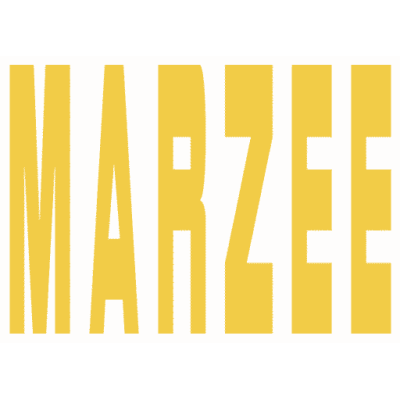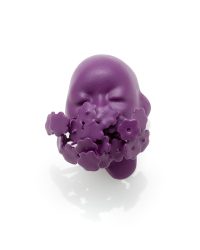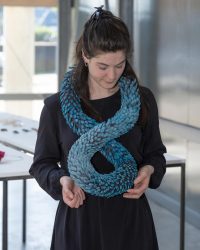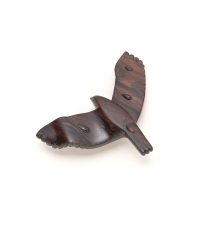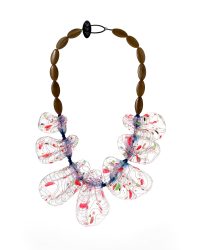TRAVERSE 가로지르다
19 alumni of the College of Design, Kookmin University, Seoul, South Korea - Dept. of Metalwork & Jewelry
30 April until 19 July 2023
"Contemporary jewelry in Korea is showing dramatic growth and the Department of Metalwork and Jewelry at Kookmin University is playing a pivotal role. The relationship between Kookmin University and Marzee started in 2007 when our students participated in the Marzee International Graduate Show. Since then, it has been an opportunity for students to make their debut as artists through the Marzee show, and after 16 years, many students have grown into great artists. You can see their growth through the exhibition, Traverse.
Traverse refers to an artistic experience based on contemporary aesthetics and lateral communication. It also means that the physical distance from Seoul to Nijmegen can be narrowed through artistic experience, and that we can communicate with each other beyond geographic and cultural differences."

Choonsun Moon
My memories are selected and everything else is forgotten.
I try to leave important scenes in my mind that I thought I needed to remember empirically.
Many images are now lost, yet I long for these erased memories.
In this series I cut and trim plates made of resin and cloth.
I want to respect the “leftovers” that are just thrown away, forms that are both coincidental and inevitable because they come from me.

Hanna Kim
Unfamiliarity always excites my curiosity and awakens ordinary daily life.
I focus on drawing ‘a fantastic grotesqueness’, based on the boundaries between territories of animals and plants.
‘The uncharted existence’ is an expression of clandestine fantasy that I draw, and a desire for a mysterious world.

Hee-ang Kim
Often likened to ‘fairies in forests’, mushrooms belong to the kingdom of fungi, neither plants nor animals. They are everywhere, then suddenly disappear without a trace.
The gills of mushrooms are the main motif in my jewellery, and the repetition and rhythm they create captivates me visually.
I imagine flipping the cap and gills inside out, revealing contrasting colours and texture. The previously inward-facing parts are now on the outside, and the outward-facing parts are now on the inside.

Heejoo Kim
My work captures the process by which pearls and coral form in the ocean.
Electroforming recreates the process of pearl formation. It expresses the liveliness of nature and its powerful energy.
The three necklaces in this exhibition express the rhythm found in the stems and branches of plants. I wanted the image and three-dimensional effect of the object to be recognisable and reminiscent of flowers, stems, fruits, and seeds.

Hyewon Kim
My work begins with making a face.
A small face wears an indistinct expression and with eyes shut, mouth firmly closed looks to be deep in thought.
I unravel my own stories through the face. They are your stories as well as mine.
If the work is a process of looking back into my forgotten memories and finding myself, then the exhibition is a way to draw viewers into the artwork and hopefully lend them a way to find their stories.

Jaewook Choi
Plastic bags are commonly used and disposed of for our convenience.
I resolved to collect and reuse them and in no time, I had collected a wide array in plentiful colours, transparent plastics and unique materials with printed lettering and patterns and crinkles.
I did not print or dye, intervene or transform the material in any way. Each piece consists of hundreds or thousands of pieces of plastic which I’ve layered. The plastic combines colours, creates unusual patterns, and makes its own unique soft and warm ‘matière.’

Jimin Kim
My work is formed in a three-dimensional shape by a surface where the cross-sectional lines of paper cut into repetitive shapes are gathered. Several layers of paper overlap to form a surface, and the surfaces are connected to form a single shape. The three-dimensional ornaments are made into many smooth, stable forms.
My repetitive actions and the repetitive shapes comfort me. The colour of the ornaments adds a pictorial element and allows the wearer to express themselves.

Jina Sim
Each everyday object makes up some sort of mental or spiritual dynamic through its existence and relationships. What I have intended in my work, thus, is to view such mundane things as aesthetic objects which exist not just for their practical purposes.
Stripped of their original purpose whilst maintaining their appearance, it is handiwork that serves as a catalyst for their metamorphosis. Without practical purpose, they evoke other meanings, both strange and familiar, enabling the viewer to look at them with a new perspective.

Joohee Han
The series Oval plays with the story of the egg that measures its own value against the standards of a surrounding society.
The abstract brooches seem like solid objects made of somewhat hard material. However, they are light, hollow, semi-transparent and flexible. As jewellery, the geometric shapes are less perfect than when placed on a table. On the body, they curve and adapt to the imperfections of the human body and this transformation from perfection to imperfection raises the question, what is the perfect version of the work/us in the end?

Jounghye Park
Plants have visual beauty, but they have brought me a different perspective through the environment and life after the COVID-19 pandemic.
I have tried to express the role and value of plants in my work.
Elements overlap and diffuse and circulate along the spiral structure, conveying the fluidity of living things.
The idea of coexistence with nature also gave birth to the Save series, created in response to a documentary about the dumping of clothes in Acra in Ghana.
It infuses use and value into useless pieces of silk. It saves things that are thrown away, and it saves us.

Junwon Jung
Sitting at the boundary between object and ornament, jewellery and sculpture, Junwon Jung’s work illustrates his preoccupation with form and function. At first glance, his pieces are objects without obvious function, flawlessly formed. Lift the lid, though, or turn the object over, and new possibilities are revealed. A steel pin, a slate ring, boxes that become brooches. The function is no longer simply that of an object and it is this blurring of identity which most intrigues him.

Junmin Bae
My work explores regular patterns, which can be observed in the process of cell division, or the eyes of insects among enormous images in the microscopic world. I also focus on characteristics such as organic shapes, the coexistence of beauty and grotesqueness that appear in the movements of proliferation and extinction, and the contrast of positive and negative feelings that can be sensed from the modification of cells or tumours. I aim to express such shapes through the process of attaching and piercing small dots on the surface of jewellery.

Minjung Cho
A plaster bandage or cast, used to fix our broken bones, preserves the human figure. It is just solid enough to keep its form when touched by water. I use it as a medium for expression and statement. Even though it appears soft and weak, it has strength and firmness and I use this paradox to reveal the identities of women.
The uterus is a symbolic representation of motherhood, filled with ambiguous stories. These intaglio ornaments are a space where women themselves can ask whether they are paradoxical existences.

Ryungjae Jung
My work defines the significance of jewellery by combining traditional metalworking techniques with 3D printing methods. The repetitive elements produced through digital replication respond to the continuous movements of the body and changes in gravity when worn, and also reflect light in the surrounding space.
The jewellery reminds the wearer of their unique connection and interaction with it, and their relationship with the surrounding environment.

Sangdeok Han
The brooch, ‘I’m running late!’, expresses the anxious emotion created by human self-awareness in a humorous way. This brooch was created to evoke empathy while observing the absurdity of our lives.
I work with rich coloured natural materials, such as red pine, bocote and ziricote wood, to make the most of their delicate patterns and hues. For the pin, I use nickel silver and stainless steel to create a sturdy yet lightweight brooch. To enhance the safety and durability of the jewellery, I applied wood oil and coating agents used for cutting boards and utensils on the surface of the wood carving.

Seulgi Kwon
Since the invention of the microscope, cells have been a source of inspiration. In English, a cell is also a small room.
I composed a ‘small room’ as a formative element in my work and made ornaments with silicone. The variable shapes, fluidity, and transparency of the physical properties of the material react according to the environment.
It is jewellery to maximize “communication” with the public and the “life” of the work. It is intended to broaden the viewer’s contemplation time and present a new formative language.

Sungyeoul Lee
Jewellery is no longer simply body adornment; some pieces widen our senses and challenge our perceptions. The idea of intimacy became a significant source of inspiration and is intrinsic to the relationship between jewellery and the wearer. In my work I am trying to visualise the intimate relationship between jewellery and our bodies. My work indicates a deep affinity with the wearer and I feel that it expresses the physical and conceptual connection between piece and wearer.

Ye-jee Lee
I work with a pressing technique using metal dies collected from the different countries.
The more I experiment, the more I find different ways to use this process. The resulting material is light and economical because its hollowness reduces the weight and amount of the material required. Flexible materials such as leather and metal mesh offer durability. Embracing these advantages, I elicit a partial differentiation in texture in the midst of the rhythmic movement and uniformity. The unpredictable contraction and expansion of the metal surface not only captures various visual effects, but also reveals the condition that had existed before the completion of the object, which evokes the unfamiliar childhood of a familiar object.

Yeseul Seo
I maintain a close connection with animals and plants, giving them my attention and listening to them with both my heart and ears.
I strive to be as innocent as possible when thinking about them and their lives. When I let go of analytical and rational judgments and don’t attempt to surpass or follow them, the resulting insights reveal many stories. The Mingling Garden is a gentle space where time moves at a leisurely pace. My hope is that it becomes an area for calmly observing and contemplating the transient lives that might have otherwise gone unnoticed, providing us with valuable insights.
